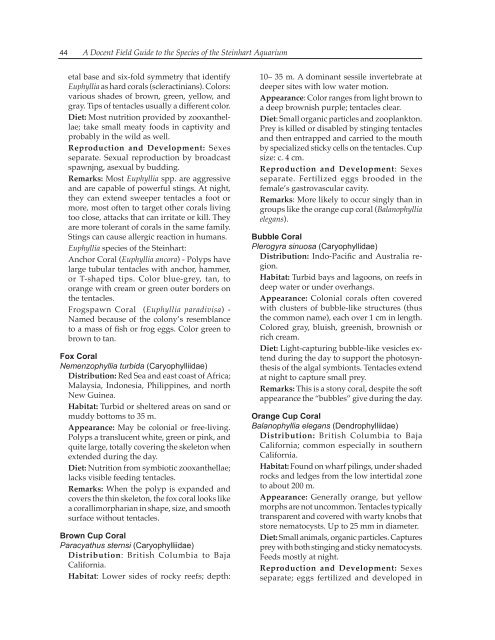THE STEINHART AQUARIUM - Gulf of Guinea Science ...
THE STEINHART AQUARIUM - Gulf of Guinea Science ...
THE STEINHART AQUARIUM - Gulf of Guinea Science ...
Create successful ePaper yourself
Turn your PDF publications into a flip-book with our unique Google optimized e-Paper software.
44 A Docent Field Guide to the Species <strong>of</strong> the Steinhart Aquarium<br />
etal base and six-fold symmetry that identify<br />
Euphyllia as hard corals (scleractinians). Colors:<br />
various shades <strong>of</strong> brown, green, yellow, and<br />
gray. Tips <strong>of</strong> tentacles usually a different color.<br />
Diet: Most nutrition provided by zooxanthellae;<br />
take small meaty foods in captivity and<br />
probably in the wild as well.<br />
Reproduction and Development: Sexes<br />
separate. Sexual reproduction by broadcast<br />
spawnjng, asexual by budding.<br />
Remarks: Most Euphyllia spp. are aggressive<br />
and are capable <strong>of</strong> powerful stings. At night,<br />
they can extend sweeper tentacles a foot or<br />
more, most <strong>of</strong>ten to target other corals living<br />
too close, attacks that can irritate or kill. They<br />
are more tolerant <strong>of</strong> corals in the same family.<br />
Stings can cause allergic reaction in humans.<br />
Euphyllia species <strong>of</strong> the Steinhart:<br />
Anchor Coral (Euphyllia ancora) - Polyps have<br />
large tubular tentacles with anchor, hammer,<br />
or T-shaped tips. Color blue-grey, tan, to<br />
orange with cream or green outer borders on<br />
the tentacles.<br />
Frogspawn Coral (Euphyllia paradivisa) -<br />
Named because <strong>of</strong> the colony’s resemblance<br />
to a mass <strong>of</strong> fish or frog eggs. Color green to<br />
brown to tan.<br />
Fox Coral<br />
Nemenzophyllia turbida (Caryophylliidae)<br />
Distribution: Red Sea and east coast <strong>of</strong> Africa;<br />
Malaysia, Indonesia, Philippines, and north<br />
New <strong>Guinea</strong>.<br />
Habitat: Turbid or sheltered areas on sand or<br />
muddy bottoms to 35 m.<br />
Appearance: May be colonial or free-living.<br />
Polyps a translucent white, green or pink, and<br />
quite large, totally covering the skeleton when<br />
extended during the day.<br />
Diet: Nutrition from symbiotic zooxanthellae;<br />
lacks visible feeding tentacles.<br />
Remarks: When the polyp is expanded and<br />
covers the thin skeleton, the fox coral looks like<br />
a corallimorpharian in shape, size, and smooth<br />
surface without tentacles.<br />
Brown Cup Coral<br />
Paracyathus sternsi (Caryophylliidae)<br />
Distribution: British Columbia to Baja<br />
California.<br />
Habitat: Lower sides <strong>of</strong> rocky reefs; depth:<br />
10– 35 m. A dominant sessile invertebrate at<br />
deeper sites with low water motion.<br />
Appearance: Color ranges from light brown to<br />
a deep brownish purple; tentacles clear.<br />
Diet: Small organic particles and zooplankton.<br />
Prey is killed or disabled by stinging tentacles<br />
and then entrapped and carried to the mouth<br />
by specialized sticky cells on the tentacles. Cup<br />
size: c. 4 cm.<br />
Reproduction and Development: Sexes<br />
separate. Fertilized eggs brooded in the<br />
female’s gastrovascular cavity.<br />
Remarks: More likely to occur singly than in<br />
groups like the orange cup coral (Balanophyllia<br />
elegans).<br />
Bubble Coral<br />
Plerogyra sinuosa (Caryophyllidae)<br />
Distribution: Indo-Pacific and Australia region.<br />
Habitat: Turbid bays and lagoons, on reefs in<br />
deep water or under overhangs.<br />
Appearance: Colonial corals <strong>of</strong>ten covered<br />
with clusters <strong>of</strong> bubble-like structures (thus<br />
the common name), each over 1 cm in length.<br />
Colored gray, bluish, greenish, brownish or<br />
rich cream.<br />
Diet: Light-capturing bubble-like vesicles extend<br />
during the day to support the photosynthesis<br />
<strong>of</strong> the algal symbionts. Tentacles extend<br />
at night to capture small prey.<br />
Remarks: This is a stony coral, despite the s<strong>of</strong>t<br />
appearance the “bubbles” give during the day.<br />
Orange Cup Coral<br />
Balanophyllia elegans (Dendrophylliidae)<br />
Distribution: British Columbia to Baja<br />
California; common especially in southern<br />
California.<br />
Habitat: Found on wharf pilings, under shaded<br />
rocks and ledges from the low intertidal zone<br />
to about 200 m.<br />
Appearance: Generally orange, but yellow<br />
morphs are not uncommon. Tentacles typically<br />
transparent and covered with warty knobs that<br />
store nematocysts. Up to 25 mm in diameter.<br />
Diet: Small animals, organic particles. Captures<br />
prey with both stinging and sticky nematocysts.<br />
Feeds mostly at night.<br />
Reproduction and Development: Sexes<br />
separate; eggs fertilized and developed in


